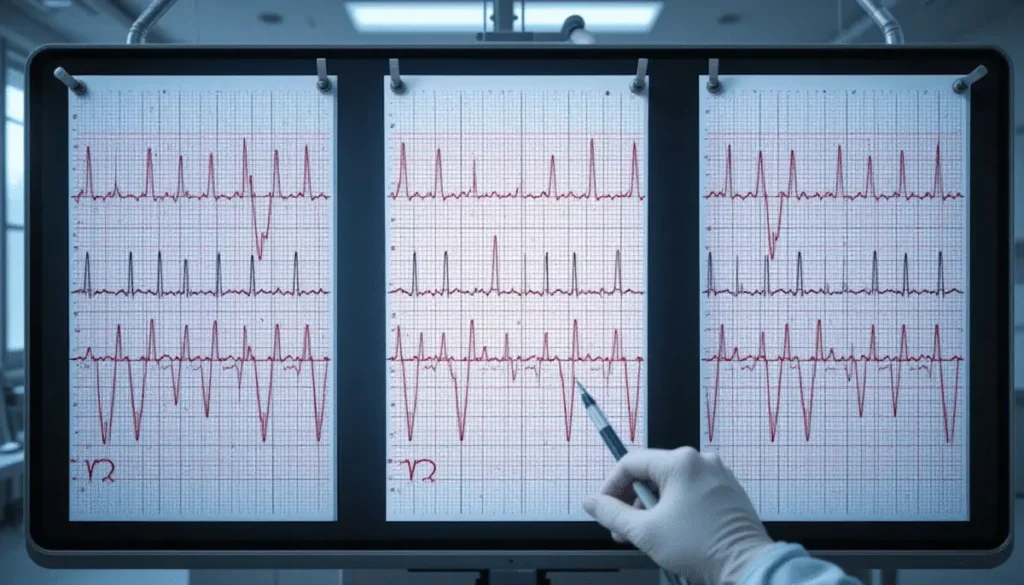The sinoatrial (SA) node is the natural pacemaker of the heart, initiating each heartbeat by generating electrical impulses. These signals cause the atria to contract and are then relayed to the ventricles through the AV node and Purkinje fibers. Any rhythm originating from the SA node is called a sinus rhythm. In this guide, we’ll break down sinus arrhythmia, sinoatrial (SA) block, sinus pause, and sinus arrest — along with how they appear on ECGs and their clinical significance.
🔹 What Is Sinus Arrhythmia?
Sinus arrhythmia is a variation in the R-R intervals while maintaining a regular P wave and consistent PR interval. There are two types:
1. Respiratory Sinus Arrhythmia (Physiological)
- Seen in healthy individuals, especially children and athletes.
- Inspiration → heart rate increases
- Expiration → heart rate decreases
- Caused by changes in intrathoracic pressure during breathing.
ECG Findings:
- Irregular rhythm (varying R-R intervals)
- P waves present and followed by QRS complexes
- PR interval and QRS duration remain normal
2. Non-Respiratory Sinus Arrhythmia (Pathological)
- Not linked to breathing.
- May indicate ischemic heart disease, sick sinus syndrome, or aging-related conduction issues.
🔹 Sinoatrial (SA) Block – Sinus Exit Block
In SA block, the SA node generates an impulse, but it fails to exit and activate the atria. The result is a missed beat on the ECG.
Key ECG Feature:
- Sudden absence of one or more PQRST complexes
- The P-P interval marches out perfectly — meaning the timing between normal P waves before and after the missed beat remains exact
This preserved timing distinguishes SA block from sinus pause or arrest.
🔹 Sinus Pause
In a sinus pause, the SA node fails to generate an impulse altogether — leading to a temporary halt in heart activity.
ECG Findings:
- One or more missed beats (absent PQRST)
- P-P intervals are NOT regular
- The next P wave appears early or delayed relative to the expected timing
🔹 Sinus Arrest
Sinus arrest is similar to sinus pause but typically longer in duration, often defined by a pause exceeding three normal P-P intervals.
ECG Findings:
- Multiple missed beats
- No electrical activity (flat line) for a prolonged period
- Irregular P-P interval
- The SA node has stopped firing completely for that duration
📊 Comparison Table
| Feature | Sinus Arrhythmia | SA Block | Sinus Pause | Sinus Arrest |
|---|---|---|---|---|
| Rhythm | Irregular | Regular except missed beat | Irregular | Irregular |
| Missed Beats | No | Yes | Yes | Yes |
| P-P Interval | Varies with breathing | Regular (marching) | Irregular | Irregular |
| Cause | Physiologic (respiratory) | Signal blocked from SA node | SA node fails to fire briefly | SA node arrests >3 beats |
| Clinical Significance | Normal in young adults | May need pacemaker if frequent | Depends on duration/symptoms | Often indicates SA node failure |
🩺 Causes of SA Block, Pause & Arrest
- Ischemic heart disease
- Myocardial infarction
- Sick sinus syndrome
- Drug toxicity: digoxin, quinidine, beta-blockers, calcium channel blockers
- Electrolyte imbalances
- Increased vagal tone
🛠️ Management Approach
- If asymptomatic: No treatment usually required.
- If symptomatic: (e.g., syncope, dizziness, severe bradycardia)
- Evaluate for medication causes
- Discontinue contributing drugs
- Consider permanent pacemaker if episodes are recurrent or prolonged
🧠 Key Takeaways
- Sinus arrhythmia is usually benign and related to breathing.
- SA block shows missing beats with constant P-P intervals.
- Sinus pause and arrest both result in missed beats without regular timing.
- Sinus arrest is diagnosed when pause lasts longer than three P-P intervals.
- Careful measurement of P waves, PR intervals, and R-R intervals is essential.



